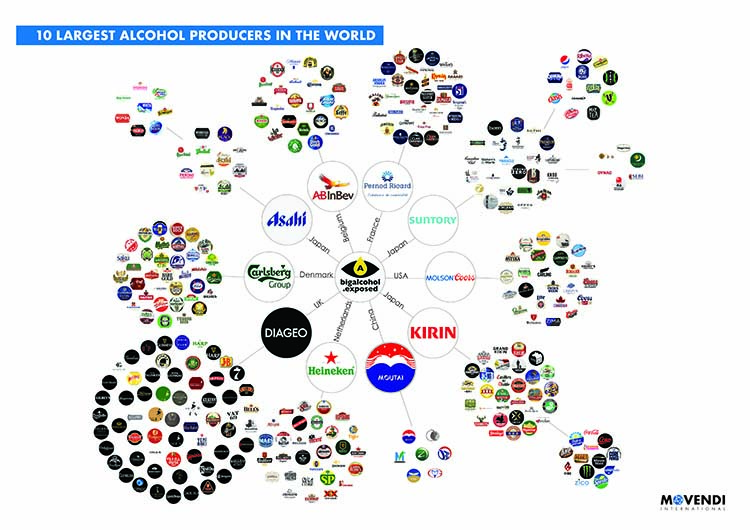The National Health and Medical Research Council (NHMRC) released updated alcohol use guidelines reducing it from 12 units of alcohol to 10 units of alcohol per week in November 2019. As Movendi International reported, the improvement to guidelines were long overdue.
Even though it has already been scientifically proven that no amount of alcohol is safe and completely risk-free for consumption, governments issue guidelines for alcohol use to reduce population risk of alcohol-related diseases.
The last time the guidelines were updated was in 2009. Since then an overwhelming amount of research evidence has been accumulating on alcohol harms showing there is no safe level for alcohol consumption.
Alcohol industry interference
Then why has it taken Australia a decade to update their guidelines? It all comes down to alcohol industry manipulation of public health policy.
At the review stage of the new guidelines, the Alcohol Beverages Australia (ABA) – a Big Alcohol front – undermined the science behind this improvement and spread misinformation about alcohol use being “good for health”. The ABA consists of and is funded by transnational alcohol giants such as Asahi Brewers from Japan, Diageo Spirits from the UK, Pernod Ricard from France, Coca-Cola Amatil and many others.

The NHMRC review of Australia’s alcohol use guidelines was opened for public submissions on the health effects of alcohol consumption. At that time, the ABA submitted a report falsely claiming consuming alcohol carries health benefits including a reduced risk of heart disease, stroke and diabetes.
In their aggressive fight against the guidelines they resurfaced this report with inaccurate information in October, 2019 right before the guidelines were issued.
Big Alcohol muddying the scientific evidence
The alcohol industry is known to muddy the scientific evidence and spreading misinformation about alcohol’s real effects. Research over the years has shown that alcohol increases the risk of many diseases including heart disease, stroke, and several types of cancer.
Research also shows now that previous studies indicating health benefits of alcohol were flawed due to selection bias and hence seriously undermined health risks from alcohol consumption.
Despite this mounting evidence the industry decided to use inaccurate research to try and derail the alcohol use guideline improvement. Of course, if people were to reduce their alcohol consumption the industry would loose on profits.
Big Alcohol using the Big Tobacco playbook
Muddying scientific evidence on harm and spreading misinformation with inaccurate science paid by the industry is a page taken straight out of the Big Tobacco playbook.
Not just with manipulation of science many other strategies used by the alcohol industry show they are following Big Tobacco strategies. Another major such strategy is using industry lobby groups made up of industry giants to manipulate and influence public health policy which could reduce consumption and prevent harm.
Big Alcohol has been opposing public health measures in Australia for years. Back in the 1950s the alcohol industry fought against the establishment of 0.05 blood alcohol content (BAC) limit for driving. Recent evidence shows that a 0.08 BAC limit more than triples the risk of having a car accident compared to 0.05 BAC.
More recently, investigation by ABC news and an analysis by the Foundation for Alcohol Research and Education (FARE) found that the alcohol industry interfered in the development of the draft National Alcohol Strategy (NAS) and undermined public health policy measures. The following were some of the examples of interference:
- A clear statement around the ‘alcohol industry having no role in developing national alcohol policy’ has been struck out, as have all safeguards to manage conflicts of interest.
- A section warning that Australia’s alcohol culture was leading to dangerous consumption was also weakened.
- Weakened language around the government’s imperative to act.
- Watered down proposed policies on pricing.
- Undermined proposed policies on advertising regulation particularly in relation to sport, and the emerging issue of targeted digital marketing.
The industry vehemently opposed alcohol warning labels which warn of risks of alcohol use during pregnancy. Since the Food Standards Australia and New Zealand (FSANZ) released a draft new label the industry has been using various arguments going from “too much information” to “too costly”. Fortunately the warning label withstood the opposition and was adopted.
Profit maximization is the alcohol industry priority which directly snd fundamentally contradicts public health. History shows that Big Alcohol will go to any length to gain profit through unethical business practices such as interference in science, aggressive lobbying, bribing, buying political influence, etc. Governments must be vigilant to ensure the private profits of a few do not harm the health and well-being of the many.
For further reading
New Resource: World Map of Big Alcohol Interference
Sources
The Australian: “Bar brawl over new limits on alcohol“
The Conversation: “How big alcohol is trying to fool us into thinking drinking is safer than it really is“
